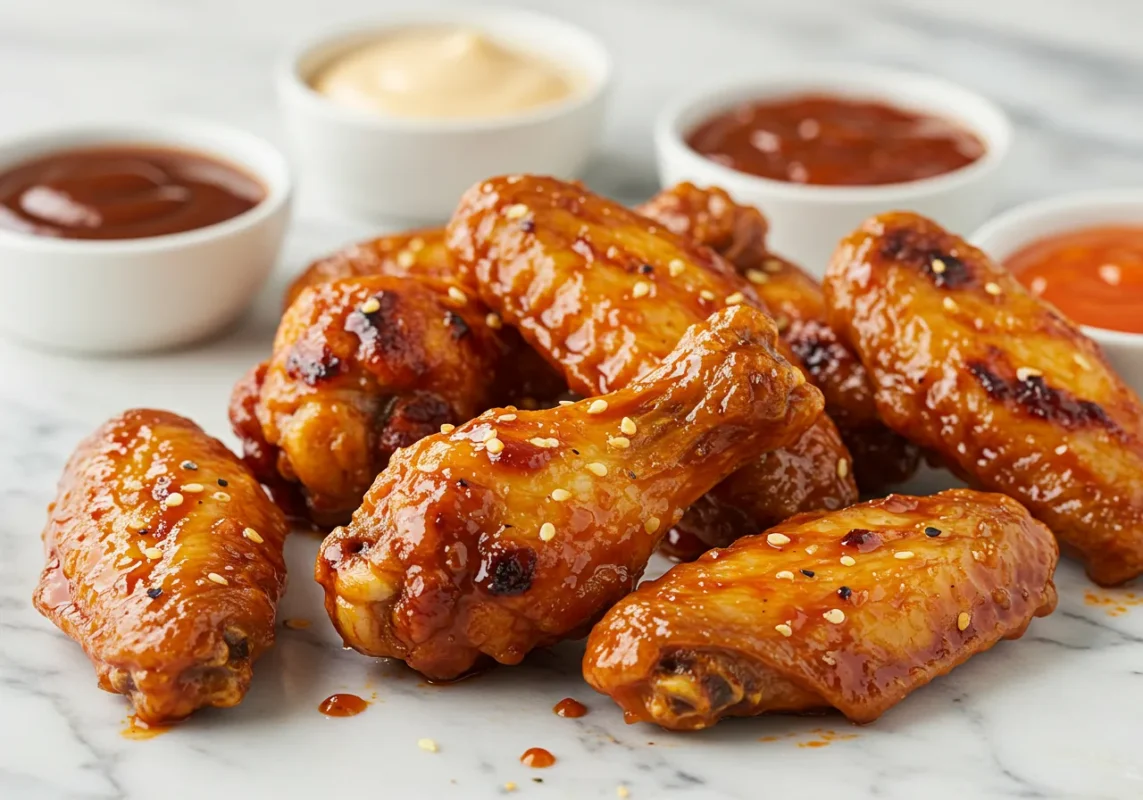Chicken wings are a beloved favorite among many; they possess an irresistible combination of flavor, texture, and variety that has made them a staple in many kitchens across the globe. Whether you’re serving them at parties, enjoying them for a casual dinner, or accompanying them with sports events on TV, chicken wings can cater to all tastes and occasions. In this article, we’ll dive deep into everything there is to know about cooking chicken wings—from achieving the ultimate crispiness to determining perfect cooking times and methods. Prepare to unlock the secrets to mouthwatering, perfectly cooked chicken wings you can enjoy anytime.
Understanding Chicken Wings
Chicken wings come from the wings of the chicken, and this part of the bird features multiple sections: the drummette, wingette, and the tip. Each section provides different textures and flavors, making it a versatile ingredient for various cooking methods. The drummette resembles a small drumstick and is meaty, while the wingette has a flatter shape with less meat but offers delightful flavor. Typically, the tip is not often used for serving but can be utilized for making rich chicken stocks due to its high collagen content.
Nutritional Value of Chicken Wings
Chicken wings are not only delicious but also pack a nutritional punch. They are primarily composed of protein and healthy fats, making them a good source of energy. However, the health benefits vary based on cooking methods. For instance, baked chicken wings are generally lower in calories compared to deep-fried wings.
To give you a clearer picture, let’s break down the nutritional value of a standard serving (about 100 grams) of chicken wings:
| Nutrient | Value per 100g |
|---|---|
| Calories | 203 kcal |
| Protein | 30 g |
| Total Fat | 9.2 g |
| Saturated Fat | 2.6 g |
| Cholesterol | 86 mg |
| Sodium | 107 mg |
| Carbohydrates | 0 g |
| Fiber | 0 g |
It’s important to note that the nutritional values can vary based on preparation and seasoning.
Best Cooking Method for Wings
When it comes to cooking chicken wings, several methods yield excellent results, but each varies based on desired texture, flavor, and convenience. Each of these methods can produce crispy and succulent wings, but frying, baking, and air-frying are among the most popular options.
Baking is preferred by many as it allows for a healthier alternative to frying while still achieving crispiness if done correctly. Frying offers a deeply flavored wing with that coveted crunch, while an air fryer provides a middle ground that combines both methods’ benefits.
Baking Vs. Frying: A Nutritional Comparison
Baking is one of the healthier options for cooking chicken wings, as it typically requires minimal oil. In contrast, frying immerses the wings in hot oil, which can significantly increase fat and calorie content. Here’s a quick comparison:
| Cooking Method | Calories (per 100g) | Total Fat (g) | Protein (g) |
|---|---|---|---|
| Baked | 203 | 9.2 | 30 |
| Deep-Fried | 400+ | 25+ | 28 |
| Air-Fried | 220 – 300 | 10 – 15 | 30 |
Factors to Consider
- Flavor: Frying enhances flavor through Maillard reaction, while baking uses seasonings to enhance taste.
- Health: Baking is generally lower in calories and fat.
- Effort: Frying requires more active monitoring, while baking is more hands-off.
Secret to Crispy Wings
The secret to achieving incredibly crispy chicken wings lies not just in cooking techniques but also in preparation. One effective method is to dry the wings thoroughly before cooking; moisture is the enemy of crispiness. After thawing, it’s crucial to pat the wings dry with paper towels.
Using Baking Powder
Additionally, using certain ingredients can enhance the crispness, such as baking powder. Baking powder raises the pH level of the chicken’s skin, allowing it to brown better and become crispier when cooked.
To incorporate baking powder into your wings preparation:
- Use 1 tablespoon of baking powder for every pound of chicken wings.
- Mix it with seasonings for added flavor.
A pro tip is to let the wings rest on a wire rack placed over a baking sheet for about 30 minutes after drying. This will allow moisture to escape and create more surface area for that fabulously crispy texture.
Baking Chicken Wings at 350 or 400 Degrees
When it comes to baking chicken wings, temperature plays a crucial role in achieving that perfect texture. While both 350 and 400 degrees Fahrenheit are viable options, the higher temperature typically yields a crisper wing.
Baking Chicken Wings at 350 Degrees
At 350 degrees Fahrenheit, the wings will take a little longer to cook but can turn out wonderfully tender and juicy. This method is suitable if you are cooking a larger batch or have time on your hands. It’s ideal for those who may be cooking other dishes simultaneously at lower temperatures.
Cooking Chicken Wings in the Oven at 400 Degrees
Baking chicken wings at 400 degrees Fahrenheit is optimal for those who crave that quick crunch. Wings cooked at this temperature usually reach an internal temperature of 165 degrees Fahrenheit (the safe minimum for poultry) in about 40-45 minutes. The result is crisp exteriors that are juicy on the inside. The key here is to flip the wings halfway through cooking to ensure even browning.
Covering Wings when Baking
To achieve the ultimate crispy results, it is advisable not to cover the wings while baking. Covering them with foil or a lid traps steam, leading to soggy skin rather than that delicious crispiness. Open baking ensures that moisture escapes while allowing the skin to become golden brown and crunchy.
Flipping Wings in the Oven
Flipping your chicken wings during baking is essential for even cooking. Halfway through the baking process, gently flip the wings using tongs to ensure that both sides attain that glorious golden hue. This simple step contributes significantly to achieving an evenly cooked and crispy wing.
Fried Chicken Wings
Fried Chicken Wings
Fried chicken wings are a beloved favorite for their rich, savory flavor and irresistible crunch. The frying process locks in moisture while creating a crispy exterior, offering a delightful contrast in texture that is hard to replicate with baking or grilling. The sound of the wings sizzling in hot oil is nearly as satisfying as the taste, making fried wings a classic indulgence at parties, sports events, or simply as comfort food.
How Long to Fry Chicken Wings
When frying chicken wings, timing is essential for achieving the perfect balance of crunch and juiciness. Typically, wings should be fried for about 10 to 12 minutes at 350°F (175°C). However, keep in mind that cooking times can vary depending on the size of the wings; larger wings may require an extra minute or two. To ensure food safety and optimal results, using a thermometer is crucial. It helps maintain the oil temperature, ensuring that the wings cook evenly and develop that desired golden-brown color.
How Long to Air Fry Chicken Wings
Air frying is an excellent alternative to deep frying for those looking to reduce oil intake while still enjoying crispy wings. When air frying chicken wings, you can expect them to take about 25 to 30 minutes at 400°F (200°C). To achieve consistent crispiness, remember to toss or shake the wings halfway through the cooking process. This movement allows hot air to circulate around the wings, eliminating any sogginess and ensuring that every side gets that crunchy exterior.
Air Fry Chicken Wings at 400 Degrees
Cooking chicken wings in an air fryer at 400 degrees yields remarkably crispy results much quicker than traditional baking methods. The air fryer uses convection to circulate hot air, which mimics the frying process while using significantly less oil. This technique not only minimizes excess fat but also simplifies clean-up. The result is perfectly crispy wings on the outside while remaining juicy and tender on the inside, making air frying a healthier twist on this classic dish.
How Long to Deep Fry Chicken Wings
For those who prefer the traditional deep-fried method, cooking chicken wings in hot oil takes about 8 to 10 minutes. To achieve the best results, it’s essential to ensure the oil is preheated to 350°F (175°C) before adding the wings. Using a thermometer makes this easier; proper oil temperature results in that ideal golden-brown color and ensures the insides are juicy and perfectly cooked.
Best Oils for Frying
The choice of oil is crucial when frying chicken wings, as it can influence both flavor and health aspects:
- Peanut Oil: Renowned for its high smoke point (around 450°F or 232°C) and nutty flavor, making it an excellent choice for frying.
- Canola Oil: A popular option due to its neutral taste, affordability, and higher omega-3 fatty acid content.
- Sunflower Oil: Another great alternative that withstands high temperatures well, allowing for effective frying without imparting strong flavors.
Each of these oils can endure the heat required for deep frying, offering a delicious flavor profile while maintaining the health benefits of lighter cooking oils.
Recipe for Crispy Baked Chicken Wings
1- Ingredients
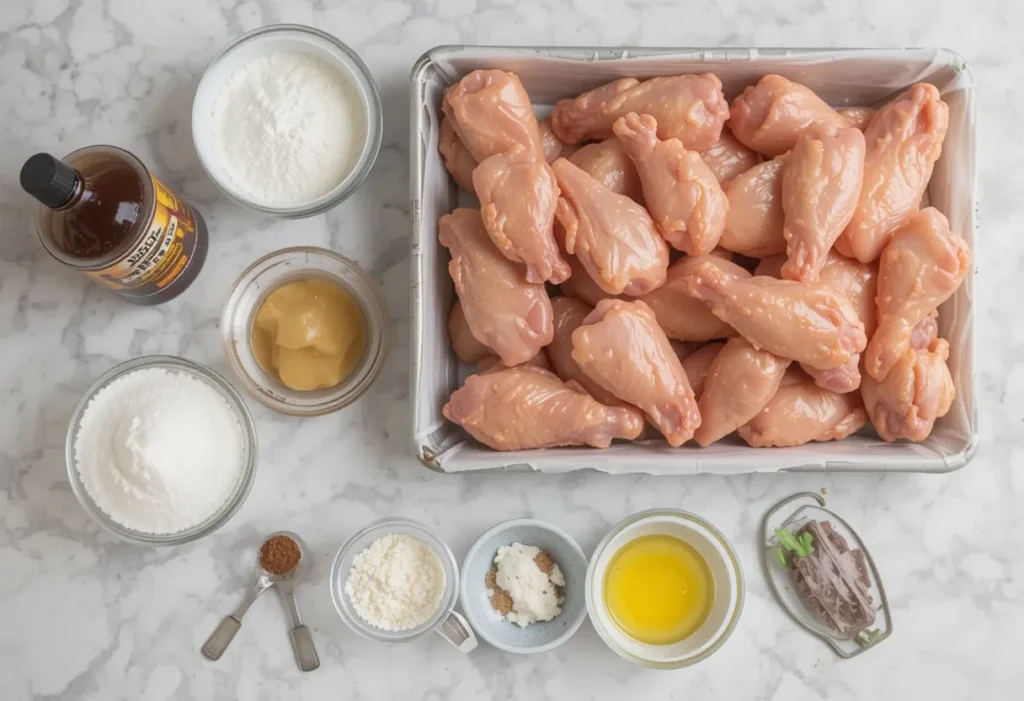
2- combine the baking powder, salt, pepper, garlic powder, and onion powder.
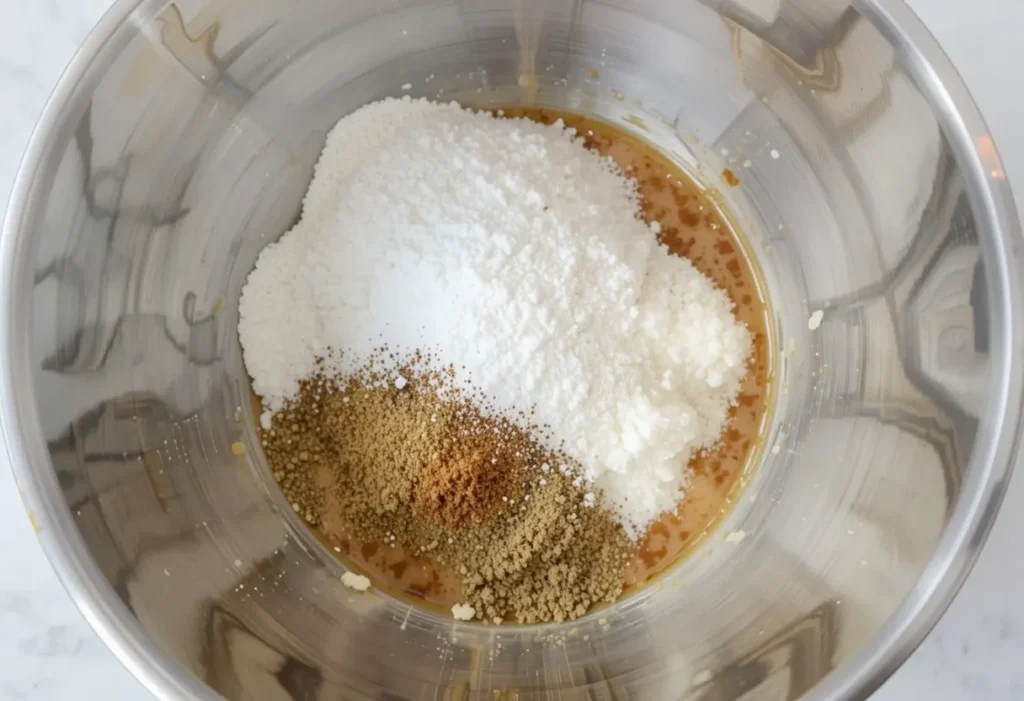
3- Evenly coat chicken wings with the spice mixture.
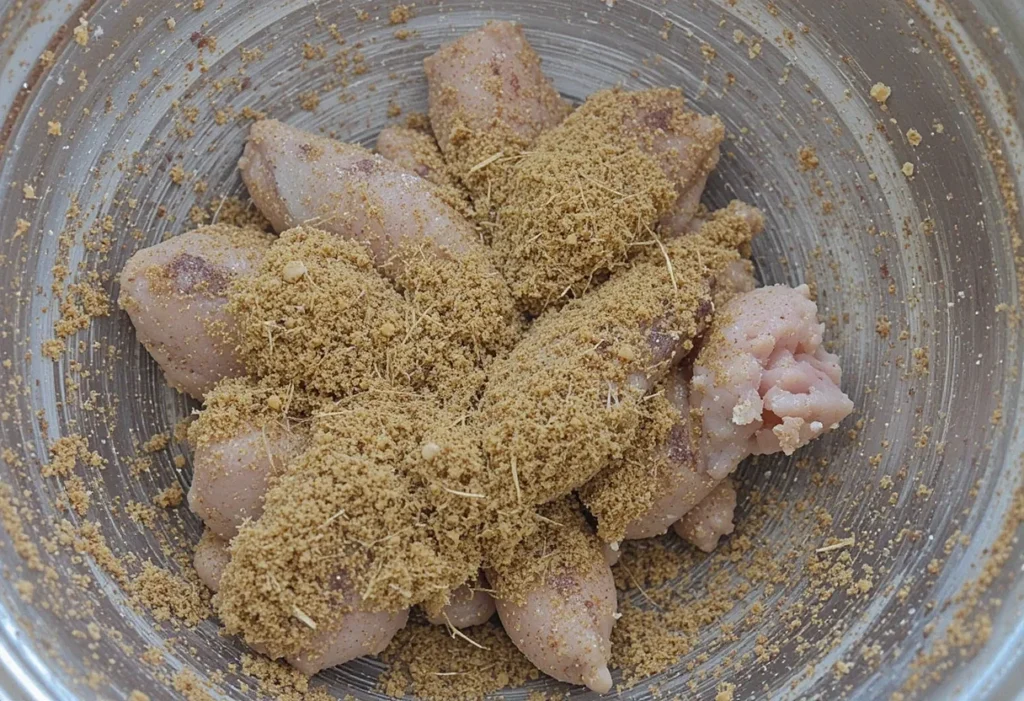
4- Arrange the wings in the wire rack or on the parchment-lined baking sheet.
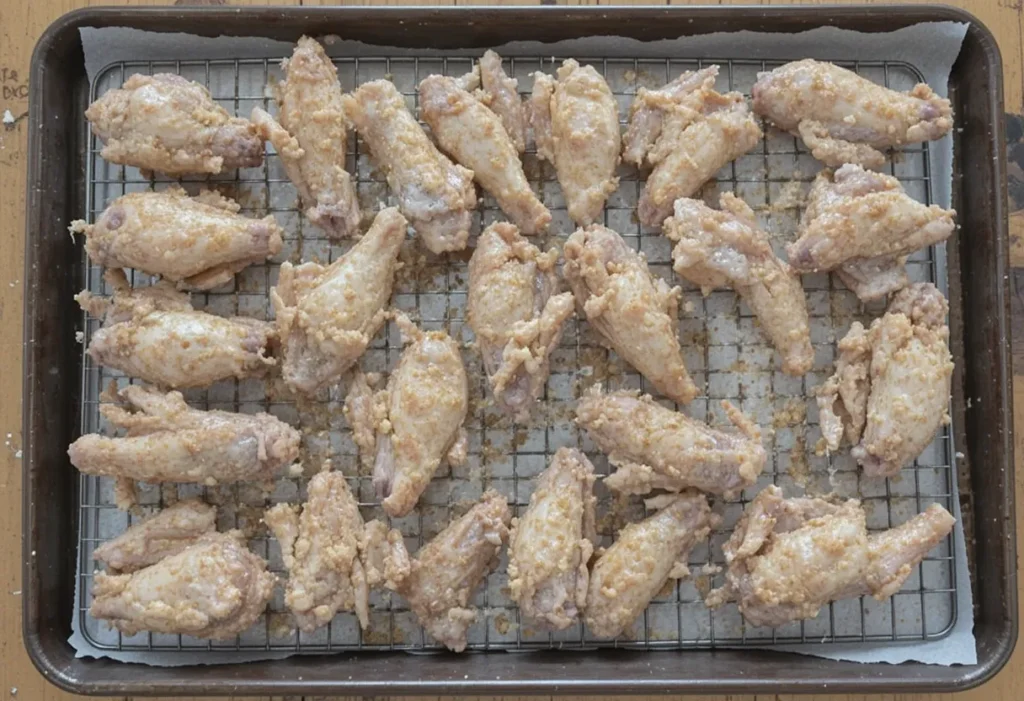
5- After baking, sauce chicken wings up and serve: Enjoy
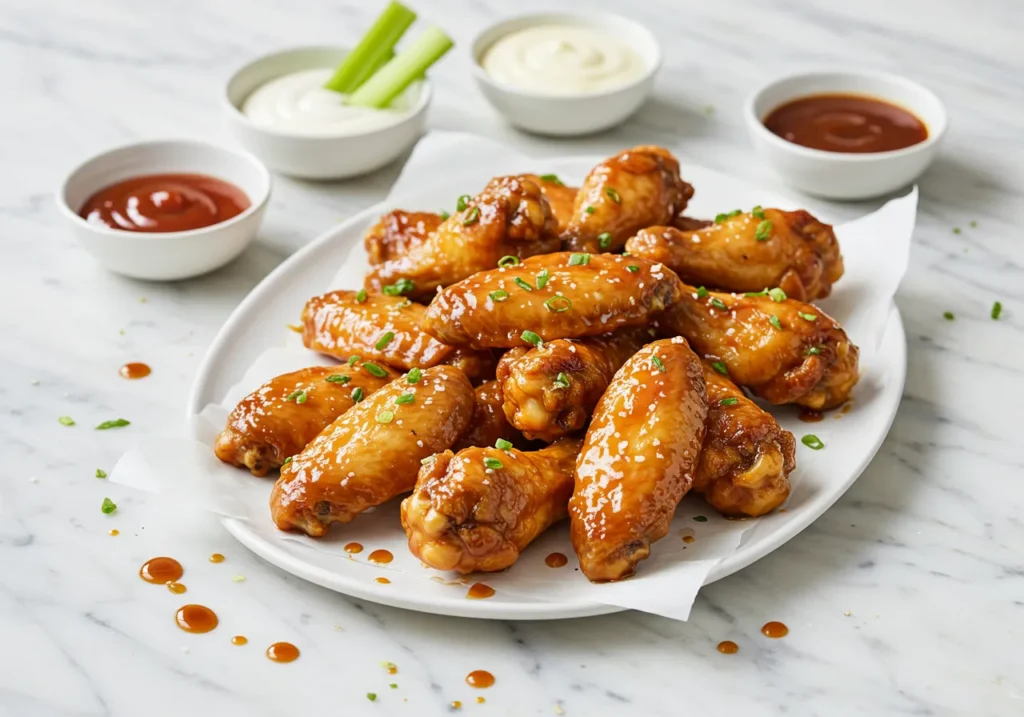
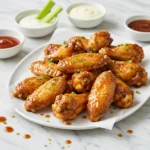
7 Deliciously Crunchy Chicken Wings
- Total Time: 55-60 min
Description
These crispy baked chicken wings are the perfect balance of tenderness and crunch, enhanced with your favorite seasonings or sauces for an irresistible flavor explosion in your mouth.
Ingredients
- 2 pounds of chicken wings, rinsed and dried
- 1 tablespoon baking powder
- 1 teaspoon salt
- 1 teaspoon black pepper
- 1 teaspoon garlic powder
- 1 teaspoon onion powder
- 1 tablespoon olive oil
- Optional: sauce of choice (Buffalo, BBQ, or Garlic Parmesan)
Instructions
- Preheat Oven: Preheat your oven to 400°F (200°C) and line a baking sheet with parchment paper. If you have a wire rack, place that on top of the baking sheet; if not, the parchment will suffice.
- Prepare the Wings: In a large bowl, combine the baking powder, salt, pepper, garlic powder, and onion powder.
- Season: Add the chicken wings to the bowl and toss until they are evenly coated with the spice mixture.
- Arrange: Arrange the wings in a single layer on the wire rack or directly on the parchment-lined baking sheet.
- Bake: Bake in the preheated oven for 40-45 minutes until golden brown and crispy, flipping the wings halfway through for even cooking.
- Crisp: If you desire extra crispiness, broil for an additional 3-5 minutes at the end of baking, watching closely to avoid burning.
- Sauce Them Up: Toss the wings in your favorite sauce or serve them plain with dipping sauces on the side.
Notes
Tips
- For the crispiest wings, ensure they are thoroughly dried before seasoning.
- Experiment with different seasonings to create your unique flavor profile.
- If you want to prepare a large batch, consider doubling your dry and spice ingredients while sticking to the same cooking times.
Disclaimer
Ensure that chicken is cooked to an internal temperature of 165°F (74°C) before consumption. Always follow safe food-handling practices.
- Prep Time: 15
- Cook Time: 40-45 min
Nutrition
- Serving Size: 4
- Calories: 400
- Sugar: 0
- Fat: 30
- Carbohydrates: 0
- Fiber: 0
- Protein: 28
The Joy of Sauce
One of the joys of chicken wings is the variety of sauces you can use. Whether you prefer spicy, tangy, or sweet, there’s a sauce for everyone.
Classic Buffalo Sauce
A staple for many, Buffalo sauce is typically made from hot sauce and melted butter. The heat levels can be adjusted by varying the amount of hot sauce used. For those who enjoy a kick, add a dash of cayenne pepper or sprinkle red pepper flakes in the sauce.
BBQ Sauce
Barbecue sauce provides a sweet and smoky flavor that pairs beautifully with chicken wings. Whether you opt for a store-bought version or decide to make your own, BBQ sauce can elevate your wings to new heights.
Garlic Parmesan
For those who prefer something less spicy, a garlic Parmesan sauce made with melted butter, garlic, and grated Parmesan cheese creates a rich, savory flavor that complements the crispy texture of the wings perfectly.
Experimenting with Flavors
Don’t hesitate to experiment with flavors! Some other ideas include teriyaki, lemon pepper, or even a honey sriracha blend for those who enjoy a combination of sweet and spicy. It’s all about personal preference and creativity!
FAQs
1. How do I store leftover chicken wings?
- In an airtight container in the refrigerator for 3-4 days or freeze for up to 2 months.
2. Can I cook frozen chicken wings without thawing?
- Yes, but cooking times will be longer (50-60 minutes at 400°F for baking).
3. What is the best method for re-heating chicken wings?
- Reheat in the oven at 350°F for 10-15 minutes or in an air fryer at 375°F for 5-7 minutes.
4. What sauces pair well with chicken wings?
- Buffalo, BBQ, Garlic Parmesan, Honey Sriracha, and Teriyaki.
5. How do I achieve an extra crispy texture on baked wings?
- Dry wings thoroughly, coat with baking powder, and bake on a wire rack.
Conclusion
In conclusion, chicken wings provide not only versatility in cooking but also endless opportunities for flavor exploration. Whether you prefer them baked for a healthier option or deep-fried for that classic indulgence, achieving crispy wings has never been easier once you understand the techniques involved. Each method has its unique perks, ensuring that there’s a cooking style to suit every culinary enthusiast’s needs.
The focus keyword for this article is “chicken wings.” This delightful dish will not only satisfy your cravings but also bring joyous moments to shared meals. Remember to explore different sauces and cooking styles as you embark on your wing-cooking journey. Each bite promises to deliver a mouthful of flavor, making it a dish worth celebrating.

